Subordinate Everything Else to the Above Decision
Subordinate to User Need Constraint
Tea Shop User Need Constraint Example
Operational knowledge required
Deciding how to Subordinate to the Constraint requires operational knowledge of your system. This note is here to point out the boundary between strategy and operations that we find ourselves on. Strategy gets you to the point of Subordinating a particular input or output to the Constraint. How you will Subordinate it depends on what actions you can take in your specific operational context.
We start with the following scenario after identifying the User Need Constraint. As a reminder, the Constraint is not enough need for Off Hours Tea Regular size.

We restate how we Decided to Exploit the above Constraint. We mentioned:
- offer a discount on Off Hours Tea Regular
- offer exclusive tea flavor only in regular size
- offer combo package that includes regular size tea
- make regular sized tea more prominent and appealing
Subordinate steps
Perform Subordinate Step 1 - For the Constraint or one of its inputs or outputs, add a single input or an output.
Focusing on the Constraint and keeping in mind decision to offer a discount on Off Hours Tea Regular, we identify that the input to that User Need is a more specific type of User, Off Hours Public. We rename the rest as Rush Hour Public and update links to correspond to specific needs.
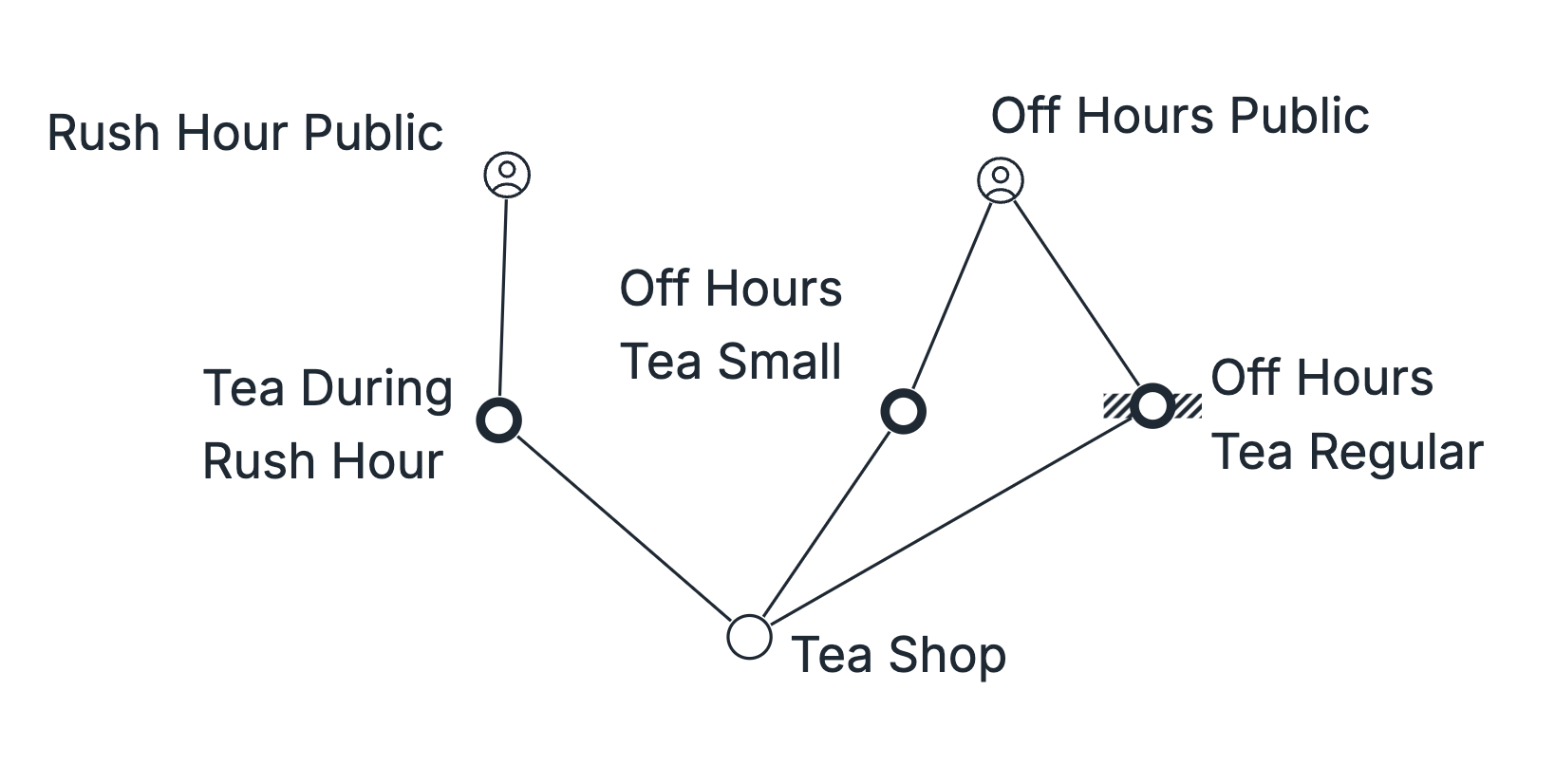
Perform Subordinate Step 2 - Select actions to take to Subordinate the input or output to the Constraint.
What actions are we to take at the Off Hours Public that will help offer a discount on Off Hours Tea Regular? This and the other decisions seem to be well suited for advertising.
- we could advertise at specific times to specific segment about:
- our discount on Off Hours Tea Regular
- our exclusive tea flavor only in regular size
- our combo package that includes regular size tea
- regular sized tea in general
We now ask, did we identify all relevant inputs and outputs and Subordinated them to the Constraint?
We will decide no. So we repeat the steps
Perform Subordinate Step 1 - For the Constraint or one of its inputs or outputs, add a single input or an output.
Thinking about why someone might want Off Hours Tea Regular instead of Off Hours Tea Small may have to do with how long they stay at the Tea Shop, with longer stays corresponding to larger cup sizes. If that's the case, another input to our constraint would be a Seating Area where Off Hours Public stays at the Tea Shop to drink their Off Hours Tea Regular.
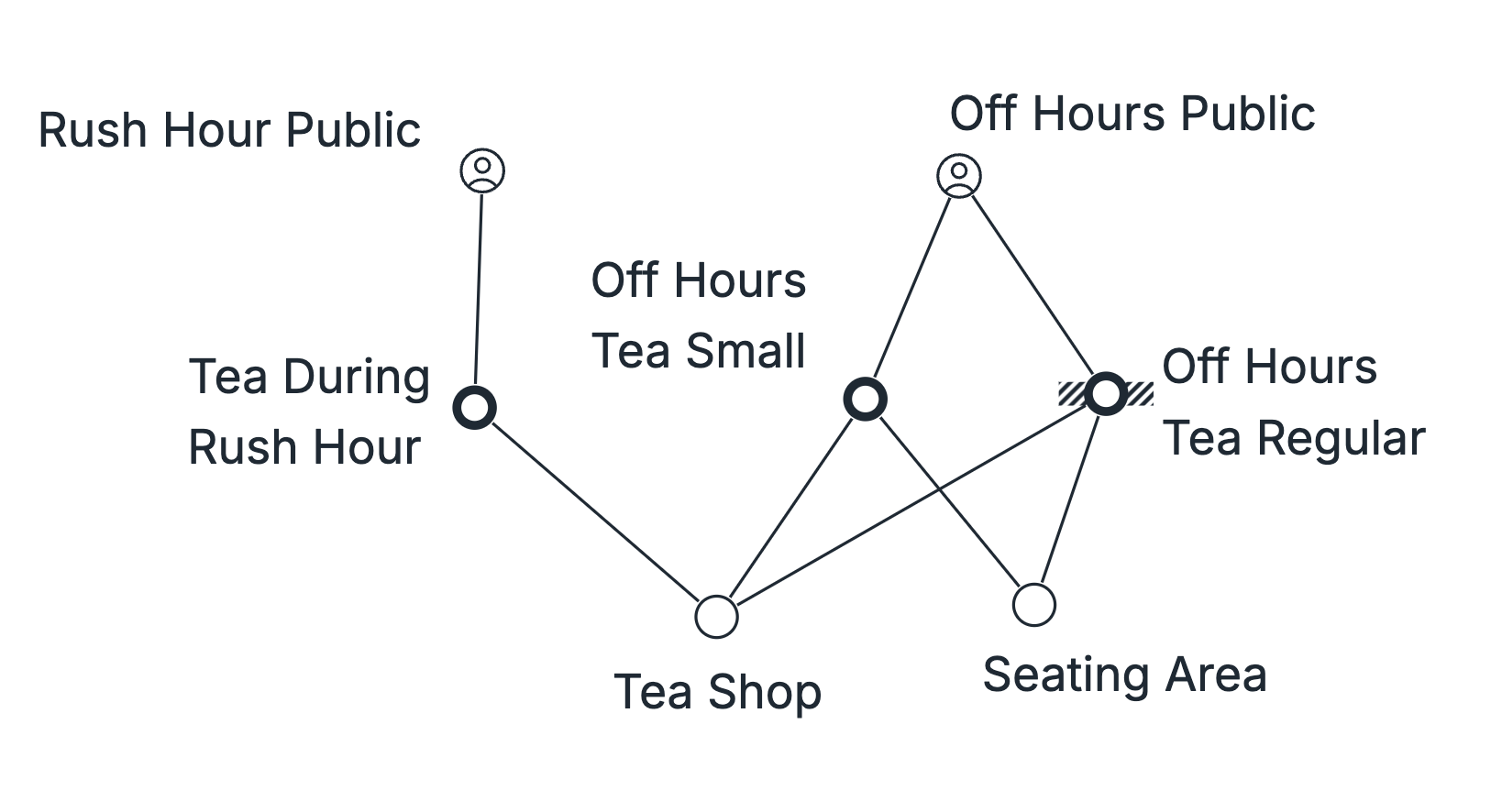
Perform Subordinate Step 2 - Select actions to take to Subordinate the input or output to the Constraint.
What actions are we to take at the Seating Area that will help offer a discount on Off Hours Tea Regular?
- the discount could be specifically for dine-in regular tea orders
What actions are we to take at the Seating Area that will help offer exclusive tea flavor only in regular size?
- again, the exclusive tea flavor could be specifically for Seating Area dine-in
What actions are we to take at the Seating Area that will help offer combo package that includes regular size tea?
- the combo package that includes regular size tea is specifically geared for Setaing Area dine-in
What actions are we to take at the Seating Area that will help make regular sized tea more prominent and appealing?
- only carry regular sized dine-in cups
We ask again, did we identify all relevant inputs and outputs and Subordinated them to the Constraint?
Let's continue and repeat the steps.
Perform Subordinate Step 1 - For the Constraint or one of its inputs or outputs, add a single input or an output.
With the context of the above actions, we realize that Staff is an important input in affecting the User Need of Off Hours Public.
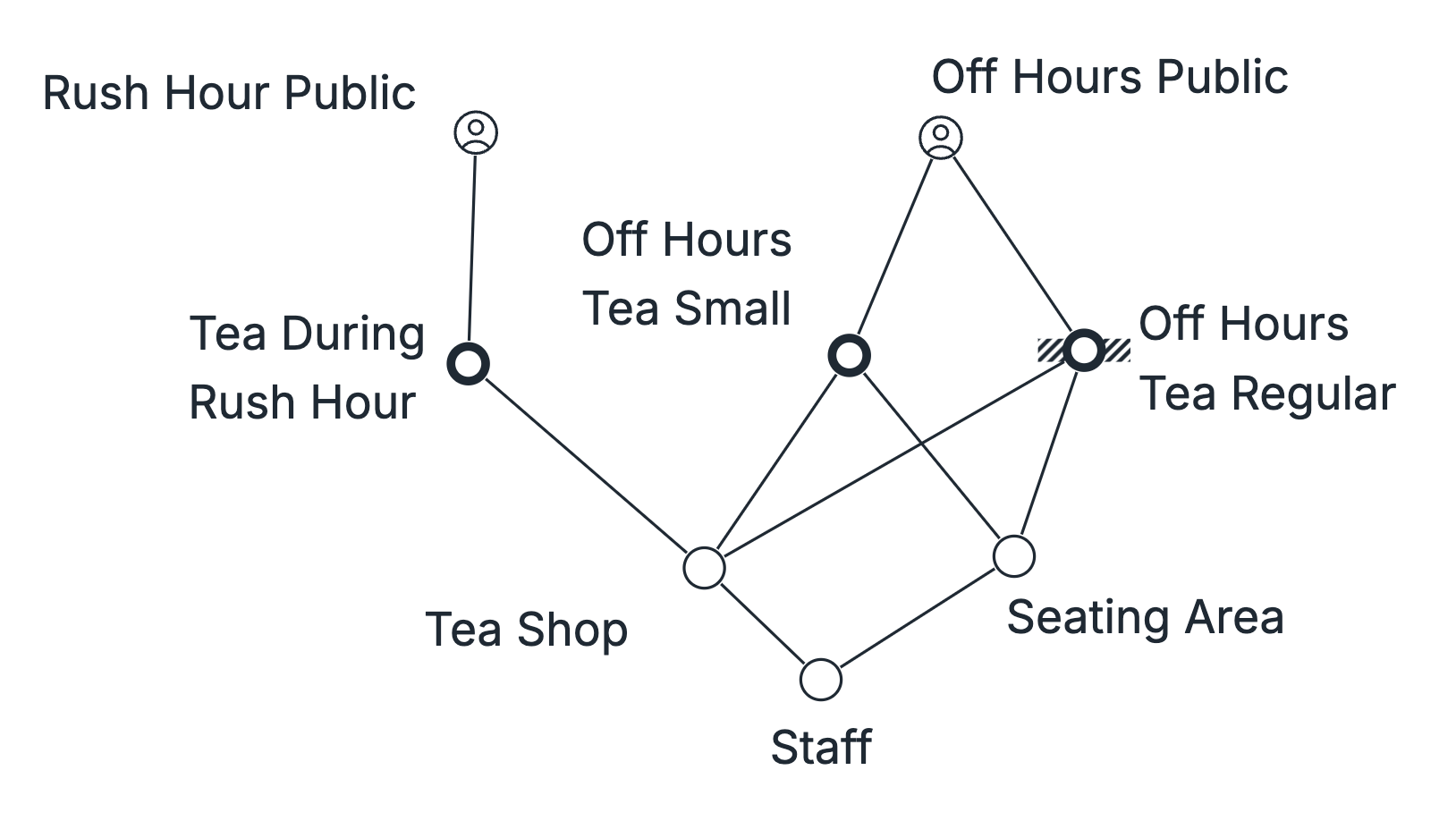
Perform Subordinate Step 2 - Select actions to take to Subordinate the input or output to the Constraint.
What actions are we to take with the Staff that will help offer a discount on Off Hours Tea Regular? This and related decisions seem well suited for training.
- train the Staff to
- ensure that Seating Area is always available for use as soon as a customer leaves
- offer dine-in discount on regular tea
- highlight exclusive dine-in tea flavor for regular sized tea
- offer dine-in combo for regualr tea orders
- highlight the dine-in experience in general during off hours
- may need to hire more Staff or reprioritize roles
We ask again, did we identify all relevant inputs and ouptuts and Subordinated them to the Constraint?
For the purpose of this example, let's stop here.
Summary and reflection
The Subordinate two-step procedure above prompted us to add detail to the Value Chain in order to Subordinate everything relevant to the Constraint. Once again, you are not modeling the entire Value Chain, but only the relevant portions for this particular step.
Furthermore, the two-step procedure generated (possibly a lot of) actions to take within the system. Since these actions are in service of Exploiting the Constraint, you should observe immediate improvement at the Constraint, and therefore in the entire flow of value of your system.
These actions could take time. Here is a list of everything generated in the example above:
- we could advertise at specific times to specific segment about:
- our discount on Off Hours Tea Regular
- our exclusive tea flavor only in regular size
- our combo package that includes regular size tea
- regular sized tea in general
- the discount could be specifically for dine-in regular tea orders
- again, the exclusive tea flavor could be specifically for Seating Area dine-in
- the combo package that includes regular size tea is specifically geared for Setaing Area dine-in
- only carry regular sized dine-in cups
- train the Staff to
- ensure that Seating Area is always available for use as soon as a customer leaves
- offer dine-in discount on regular tea
- highlight exclusive dine-in tea flavor for regular sized tea
- offer dine-in combo for regualr tea orders
- highlight the dine-in experience in general during off hours
- may need to hire more Staff or reprioritize roles
You are now doing strategy!
Richard P. Rumelt wrote that good strategy has a kernel made of three parts1:
- diagnosis that explains the nature of the challenge
- guiding policy for dealing with the challenge
- coherent actions required to carry out the guiding policy
In this sense, you performed diagnosis when you Identified the System Constraint. You created the guiding policy when you Decided How to Exploit the System's Constraint. And now, you generated a set of coherent actions by Subordinating Everything Else to the Decision.
While there is still much more to strategy, you are on your way.
Rumelt, R.P. (2012), "Good Strategy/Bad Strategy: The Difference and Why It Matters", Strategic Direction, Vol. 28 No. 8. https://doi.org/10.1108/sd.2012.05628haa.002
Up next
After taking action in your system and observing the effects, you may need to revisit the Subordinate steps above.
Once you feel that you Subordinated everything to the Constraint, then it may be time to Elevate the System's Constraint, proceed there next.
If you are curious what Subordinating to the Constraint is like for User or Component, visit the Subordinate to User Constraint or Subordinate to Component Constraint lessons.
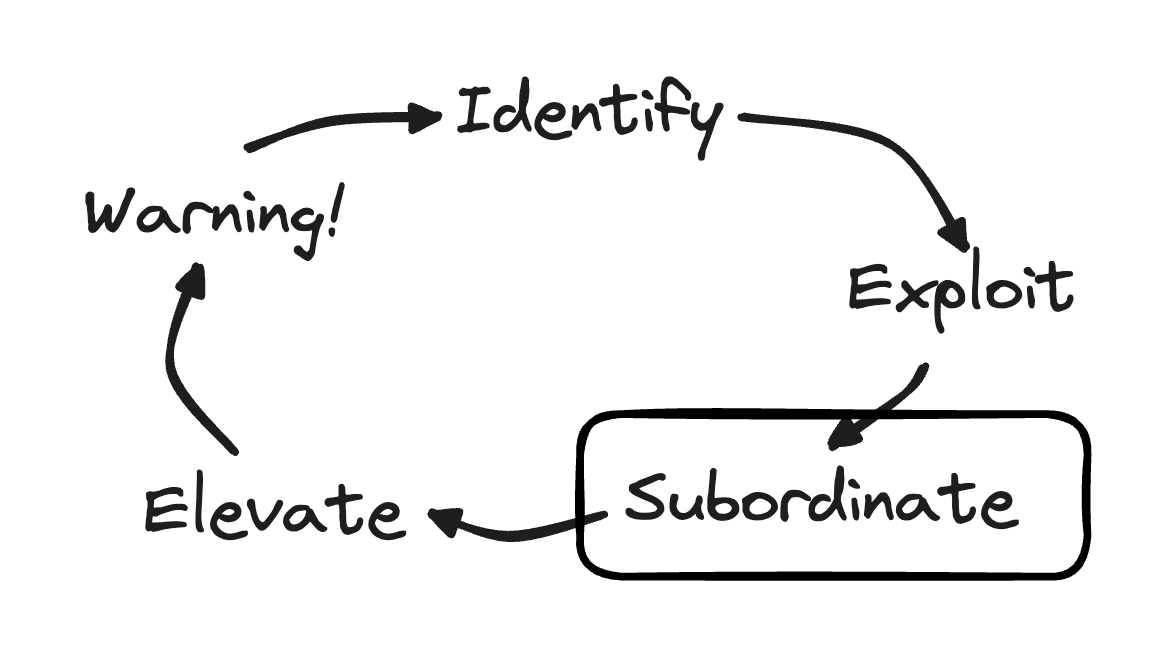
Go back
Subordinate Everything Else to the Above Decision
Learn to subordinate all non-constraints to the primary constraint in your value chain. This guide helps identify relevant non-constraints and ensure efficient flow of value through the system.
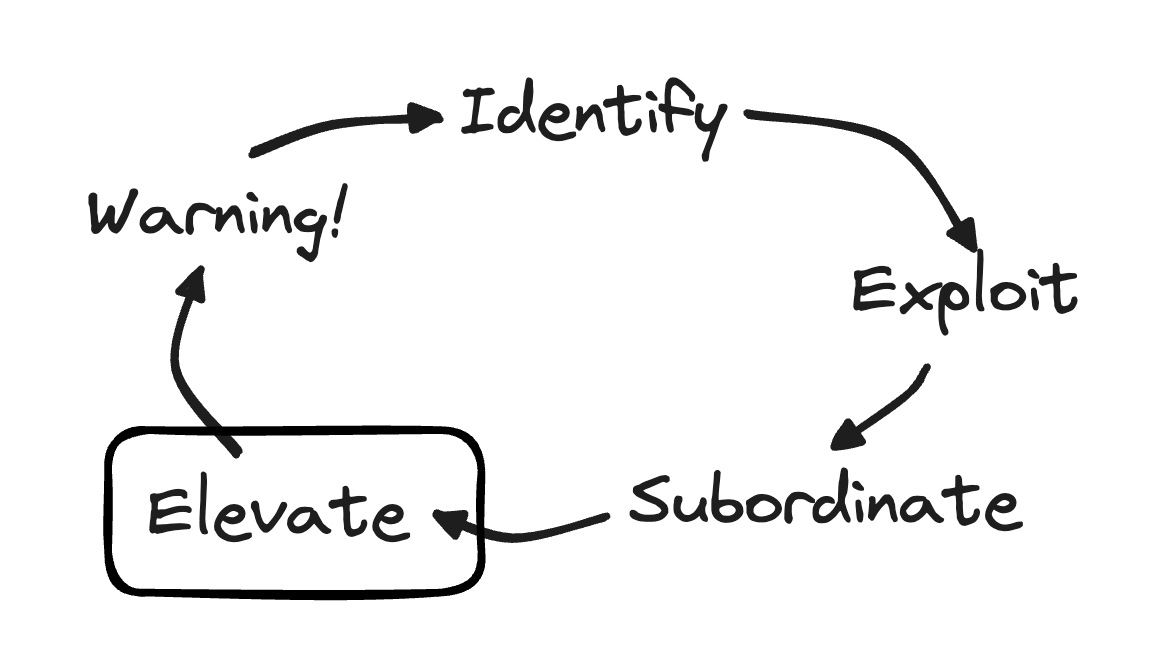
Up next
Elevate the System's Constraint
Explore the process of elevating the system's constraint by stepping out of the process flow and considering evolutionary stages. Learn how to identify, exploit, and elevate constraints within your system.
